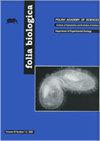Development of Fannia pusio (Diptera: Fanniidae) Under Controlled Temperature Conditions and its Enforcement in the Estimate of the Post-mortem Interval (PMI)
IF 0.8
4区 生物学
Q4 BIOLOGY
引用次数: 1
Abstract
Fannia pusio (Wiedemann, 1830) is a species belonging to the family Fanniidae, which is of great forensic, sanitary, and veterinary interest. The behavioral peculiarities of this species, depending on the temperature at which it is found, may provide additional information for future research. The application of entomology in the forensic field has focused especially on the early colonizing taxa of corpses that are in the initial stage of decomposition. However, species occurring at more advanced stages can contribute to further knowledge, as is the case with F. pusio. In addition, the species has the ability to colonize buried corpses that are inaccessible to larger dipterans. On the other hand, the sanitary and veterinary interest of this species is due to the performance of females as phoretic hosts of Dermatobia hominis eggs that cause myiasis in both animals and humans. In the current study, the behavior of F. pusio was observed at a temperature range of 5°C to 40°C. We found that its viability range is limited between 15°C and 35°C; above and below these temperatures, adults survive but oviposition does not take place. Data collected by statistical analysis were subsequently applied to calculate the post-mortem interval (PMI) using isomorphen and isomegalen diagrams. The results show a directly proportional relationship between growth rate and temperature increase. However, a slowdown in the growth of individuals was observed at extreme temperatures (5°C and 35°C). The results shown in this manuscript, together with the existing bibliography of other species, help to broaden the knowledge of F. pusio, which has not been studied in such depth until now.控制温度条件下pusio Fannia(Diptera:Fanniidae)的发育及其在估计死后间隔(PMI)中的应用
Fannia pusio (Wiedemann, 1830)是Fanniidae科的一种,具有重要的法医、卫生和兽医意义。这个物种的行为特点取决于它被发现时的温度,这可能为未来的研究提供额外的信息。昆虫学在法医领域的应用主要集中在处于分解初期的尸体的早期殖民分类群上。然而,发生在更高级阶段的物种可以为进一步的知识做出贡献,就像假单胞菌一样。此外,这个物种有能力在大型双翅目动物无法到达的掩埋尸体上定居。另一方面,这一物种的卫生和兽医利益是由于雌性作为人类皮癣虫卵的传播宿主的表现,导致动物和人类的蝇蛆病。在本研究中,观察了F. posio在5°C至40°C温度范围内的行为。我们发现其生存能力范围限制在15 ~ 35℃之间;高于或低于这个温度,成虫都能存活,但不能产卵。通过统计分析收集的数据随后应用于使用同构图和等ω图计算死后间隔(PMI)。结果表明,生长速率与温度升高成正比关系。然而,在极端温度(5°C和35°C)下,观察到个体的生长放缓。本文所显示的结果,与已有的其他物种的参考书目一起,有助于拓宽对F. pusio的认识,迄今为止还没有对其进行过如此深入的研究。
本文章由计算机程序翻译,如有差异,请以英文原文为准。
求助全文
约1分钟内获得全文
求助全文
来源期刊

Folia Biologica-Krakow
医学-生物学
CiteScore
1.10
自引率
14.30%
发文量
15
审稿时长
>12 weeks
期刊介绍:
Folia Biologica (Kraków) is an international online open access journal accepting original scientific articles on various aspects of zoology: phylogeny, genetics, chromosomal studies, ecology, biogeography, experimental zoology and ultrastructural studies. The language of publication is English, articles are assembled in four issues per year.
 求助内容:
求助内容: 应助结果提醒方式:
应助结果提醒方式:


